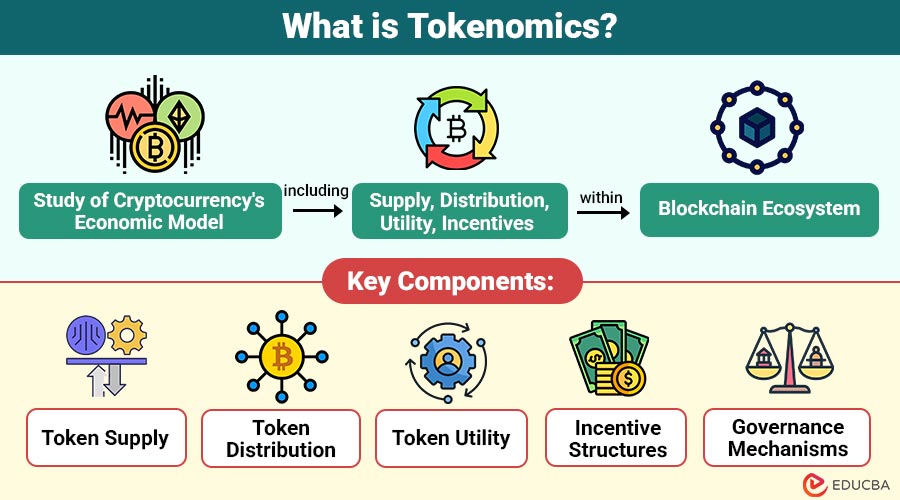What is Tokenomics? A Beginner’s Guide to Crypto Economics



What is Tokenomics?
Tokenomics, a blend of “token” and “economics.” It refers to the study of a cryptocurrency’s economic model, including supply, distribution, utility, and incentives within its blockchain ecosystem.
Essentially, tokenomics explains:
- How a token is created and distributed.
- How it gains and maintains value.
- How it incentivizes users, developers, and investors.
Good tokenomics ensures that a token is not only functional but also sustainable and attractive to users and investors. Whether you are an investor, developer, or enthusiast, understanding tokenomics is key to evaluating the potential success and risks associated with a crypto project.
Table of Contents
What is a Token?
Before diving into tokenomics, it is essential to understand what a token is. In the cryptocurrency world, a token represents a digital asset that can serve multiple purposes within a blockchain ecosystem. Some of the types include:
- Currency: Tokens like Bitcoin (BTC) and Ethereum (ETH) serve as mediums of exchange.
- Utility: Tokens can provide access to services or features within a platform. For example, Binance Coin (BNB) is used to pay fees on the Binance Exchange.
- Governance: Certain tokens give holders the power to vote on project decisions, exemplified by decentralized autonomous organizations (DAOs) such as MakerDAO.
- Security: Security tokens represent ownership or investment in real-world assets, such as shares or bonds.
Importance of Tokenomics
Tokenomics is crucial because it determines:
- Value Creation: Strong tokenomics provides real-world use cases and drives demand.
- Sustainability: It ensures that the token does not collapse due to inflation, oversupply, or lack of adoption.
- Investor Confidence: Clear and fair tokenomics attracts investors and reduces risks.
- Ecosystem Growth: Well-structured incentives encourage participation, staking, governance, and liquidity provision.
For example, Bitcoin’s tokenomics—fixed supply of 21 million coins, halving events reducing supply, and decentralized mining rewards—are key reasons it is considered a store of value.
Key Components of Tokenomics
Tokenomics consists of several interrelated components that determine the functionality, stability, and growth potential of a cryptocurrency project. Every element contributes critically to defining the token’s overall economic framework.
1. Token Supply
Token supply defines the total number of tokens in existence and the schedule for their release. It directly impacts scarcity and, consequently, the token’s value.
- Total Supply: This is the maximum number of tokens that will ever exist. It sets the upper limit and creates a sense of scarcity.
- Circulating Supply: The total quantity of tokens that are currently in circulation and available for trading or utilization. This influences market liquidity and price volatility.
- Inflationary vs. Deflationary Models: Some tokens increase supply over time (inflationary), while others reduce supply through mechanisms like token burns (deflationary).
2. Token Distribution
Token distribution shows how stakeholders receive tokens, including developers, investors, the community, and the project team. Fair and strategic distribution ensures decentralization and sustainable growth.
- Pre-mined or ICO Allocation: Early investors and founders receive tokens during fundraising events such as Initial Coin Offerings (ICOs) or Private Sales.
- Mining or Staking Rewards: Users earn tokens by participating in the network through activities like mining or staking, which incentivizes them to secure and maintain the blockchain.
- Airdrops and Incentives: Tokens distributed to users for marketing, community growth, or platform engagement.
Example: Ethereum allocated tokens during its early crowdsale to fund development and reward early adopters, while reserving a portion for the development team to support ongoing network operations.
3. Token Utility
Token utility defines the specific purpose a token serves within its ecosystem. A token’s utility ensures adoption and creates a reason for users to hold or use it.
- Payment Tokens: Function as a means of payment for goods and services, such as Bitcoin.
- Governance Tokens: Enable holders to vote on project proposals and influence decision-making (e.g., Uniswap’s UNI).
- Utility Tokens: Grant access to platform features or services (e.g., Binance Coin for trading fee discounts).
Example: Chainlink uses its LINK token to pay node operators for supplying real-world data to smart contracts, making the token essential for the platform’s functionality.
4. Incentive Structures
Incentive structures motivate participants to engage with the network, ensuring active participation, security, and ecosystem growth.
- Staking Rewards: Users lock their tokens to validate transactions and maintain network security, earning rewards in return.
- Liquidity Mining: Users provide tokens to liquidity pools on decentralized exchanges to facilitate trading and earn rewards.
- Referral and Loyalty Programs: Encourage users to onboard others and reward continued engagement.
5. Governance Mechanisms
Governance mechanisms determine how participants make decisions within a blockchain ecosystem. They ensure that token holders have a voice in critical updates, upgrades, or policy changes.
- Decentralized Voting: Token holders vote on proposals affecting protocol rules or token economics.
- Community Engagement: Encourages active participation in project development, promoting transparency and decentralization.
- Proposal Incentives: Some platforms reward users for submitting viable governance proposals that benefit the ecosystem.
Example: MakerDAO allows MKR token holders to vote on decisions that govern the DAI stablecoin, balancing community input with protocol sustainability.
Examples of Tokenomics in Practice
Let us explore how tokenomics operates in real projects:
1. Bitcoin
- Supply: Fixed at 21 million BTC
- Distribution: Mining rewards for miners
- Incentives: Miners earn rewards for validating transactions
- Scarcity: Limited supply drives demand over time
2. Ethereum
- Supply: Initially inflationary, with mechanisms like EIP-1559 introducing deflationary features
- Utility: Used to pay for gas fees in smart contracts
- Incentives: Validators earn rewards through staking under Ethereum 2.0
3. Binance Coin (BNB)
- Supply: Initially 200 million tokens; regular token burns reduce total supply
- Utility: Discounts on trading fees, payments, and participation in token sales
- Incentives: Encourage active use of the Binance ecosystem
How to Analyze Tokenomics Before Investing?
Investors should evaluate the following:
- Supply Cap & Inflation: Understand whether the token is scarce or inflationary.
- Distribution: Assess the concentration of ownership and decentralization.
- Utility: Determine if the token has a critical use case.
- Incentives: Check if rewards align with network growth and engagement.
- Governance: Verify if token holders have meaningful decision-making power.
Tools: Platforms like CoinGecko and CoinMarketCap provide detailed token supply, distribution, and use case data.
Conclusion
Tokenomics is not just a technical term—it is the backbone of any blockchain project. A well-structured tokenomics model balances supply, utility, governance, and incentives to create a thriving ecosystem. By understanding tokenomics, investors, developers, and users can make informed decisions about which projects to participate in and how to maximize value from tokens.
Recommended Articles
We hope this detailed guide on tokenomics helps you understand cryptocurrency economics better. Check out these recommended articles for more insights and strategies to explore investment opportunities.
- Cryptocurrency Cost Basis Methods
- Trading Major Economic Events
- Invest in Cryptocurrency
- Crypto Whitepaper



